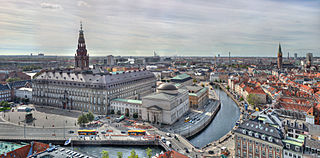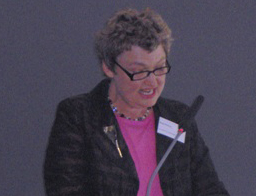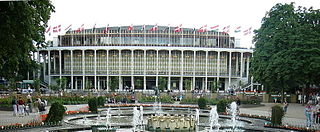
Copenhagen is the capital and most populous city of Denmark, with a population of around 660,000 in the municipality and 1.4 million in the urban area. The city is on the islands of Zealand and Amager, separated from Malmö, Sweden, by the Øresund strait. The Øresund Bridge connects the two cities by rail and road.

The University of Copenhagen is a public research university in Copenhagen, Denmark. Founded in 1479, the University of Copenhagen is the second-oldest university in Scandinavia after Uppsala University.

Aarhus University is a public research university with its main campus located in Aarhus, Denmark. It is the second largest and second oldest university in Denmark. The university is part of the Coimbra Group, the Guild, and Utrecht Network of European universities and is a member of the European University Association.

The IT University of Copenhagen is a public university and research institution in Copenhagen, Denmark. It is specialized in the multidisciplinary study of information technology within computer science, business IT and digital design.

The Danish National Symphony Orchestra, is a Danish orchestra based in Copenhagen. The DNSO is the principal orchestra of DR. The DRSO is based at the Koncerthuset concert hall in Copenhagen.
Una Canger is a Danish linguist specializing in languages of Mesoamerica. She has published mostly about the Nahuatl language with a particular focus on the dialectology of Modern Nahuatl, and is considered among the world's leading specialists in this area. She held tenure at the University of Copenhagen, leading the department for Native American Languages and Cultures until she reached the age of 70 in 2008 and was forced into retirement. In 2012 she was awarded the Order of the Aztec Eagle for her contributions to the study of Mexican culture. In 2005 she received the teaching prize of Copenhagen University, the Harald.

Martin Borch (1 March 1852 – 8 February 1937) was a Danish architect.
Peter Harder is a Danish linguist and professor of English language at the University of Copenhagen. He is notable as a cofounder of the Danish Functional Linguistics stage of the Copenhagen School in linguistics. He has worked extensively with functional linguistic theories and speech act theory. In Denmark, he is best known amongst the general public for his outspoken criticism against the Danish government's tight regulation of research, which he perceives as a threat to academic freedom.

Albert Gjedde: is a Danish-Canadian neuroscientist. He is Professor of Neurobiology and Pharmacology at the Faculty of Health Sciences and Center of Neuroscience at the University of Copenhagen. He is currently also Adjunct Professor of Neurology and Neurosurgery in the Department of Neurology, Montreal Neurological Institute, McGill University, Montreal, Quebec, Canada, Adjunct Professor of Radiology and Radiological Science in the Division of Nuclear Medicine, Department of Radiology and Radiological Science, Johns Hopkins University, Baltimore, Maryland, US, Adjunct Professor of Translational Neuropsychiatry Research, University of Southern Denmark, Odense, Denmark, and adjunct professor of psychiatry at Tabriz University of Medical Sciences, Tabriz, East Azerbadjan, Iran.

Margit Warburg is a Danish sociologist of religion. Since 2004, she has been professor of Sociology of Religion in the Department of Cross-Cultural and Regional Studies at the University of Copenhagen. She was an associate professor at the same university from 1979 to 2004.

Sølvgade Barracks is a former military facility from 1771 located on the corner of Sølvgade and Øster Voldgade in central Copenhagen, Denmark. The barracks closed in 1926 and the large Baroque complex designed by Nicolas-Henri Jardin then served as headquarters for DSB, the Danish state railways, until 2013, when the building was converted into student apartments.

Israels Plads is a large public square in central Copenhagen, Denmark, located in the area between Nørreport station and The Lakes. Its northern part hosts a market. Its southern part was extensively redesigned in 2014, with transition into the adjacent Ørsted Park.

Tivoli Concert Hall is a 1,660-capacity concert hall at Tivoli Gardens in Copenhagen, Denmark. The building, which was designed by Frits Schlegel and Hans Hansen, was built between 1954 and 1956. The concert hall is used for classical music, Broadway musicals, and jazz musicians.

Mateusz Krzysztof Maksymilian Molęda is a German-Polish conductor.

Store Kannikestræde is a street in the Old Town of Copenhagen, Denmark, connecting Frue Plads to Købmagergade. Its history is closely associated with the University of Copenhagen and some of Copenhagen's oldest halls of residence are located in the street. It has been pedestrianized since 1973.

The Latin Quarter is a neighbourhood in central Copenhagen, Denmark. It is bounded by Nørregade to the west, Vestergade to the south, Vester Voldgade to the east and Nørre Voldgade to the north. The name refers to the Latin language, which was once widely spoken in and around the University, whose historic home is situated on the other side of Nørregade. Most of the student life has now been relocated to four new campuses but the area is still known for its lively atmosphere with an abundance of boutiques, cafés and night clubs.

Frederiksberg Campus is one of the four main campuses of University of Copenhagen in Copenhagen, Denmark. It is located in Frederiksberg and is home to large parts of the Faculty of Science' activities within the fields of natural science and biosciences as well as part of the School of Veterinary Medicine and Animal Science at the Faculty of Health and Medical Sciences, including the University Hospital for Companion Animals. The main campus is located on the west side of Bülowsvej, on both sides of Thorvaldsensvej and Rolighedsvej. It occupies the former grounds of the Royal Veterinary and Agricultural University (KVL) which was merged into the University of Copenhagen in 2007. The main building at Bülowsvej No. 17 is from 1895.

The Centre for Advanced Migration Studies (AMIS), is a research centre at the University of Copenhagen in Denmark. It engages in interdisciplinary research and postgraduate teaching concerning human migration. The centre is part of a growing trend in recognizing migration studies as a distinct field of academic research.

The National Union of Students in Denmark, is an umbrella organisation of students' unions at higher education facilities in Denmark. Since 1932, DSF has represented the students of Denmark in matter of education policy.
Paula Tatiana (Tania) Ørum is a Danish feminist, literary historian and writer who has specialized in women's and gender studies. Together with Lene Koch, in the 1970s she was one of the driving forces behind recognition of the need for university courses in women's research. This later led to the Danish gender and women's research centre KVINFO, to which she contributed from 1981 to 1990. Her own research has focused on the relationship between gender and literature as can be seen in her Pamelas Døtre (1985). Since her retirement in 2015 from the University of Copenhagen's Department of Arts and Cultural Studies, she continues to be an active writer and speaker, especially in connection with avant-garde art in the 1960s.

















